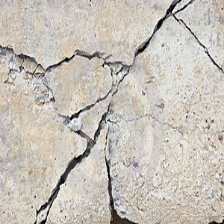Here I present my solution to the problem crack segmentation for both pavement and concrete meterials. In this article, I describe the approaches, dataset that I exprimented with and desmonstrate the result. My approach is based on the UNet network with transfer learning on the two popular architectures: VGG16 and Resnet101. The result shows that a large crack segmentation dataset helps improve the performance of the model in diverse cases that could happen in practice.
- Inference Result Preview
- Overview
- Dataset
- Dependencies
- Test Images Collection
- Inference
- Training
- Result
- Citation
Below are the results from several test cases. For more test case results, please see images under the folder ./test_results
Crack segmentation is an important task in structure investigation problems. For example, in the bridge investigation project, a done is controlled to fly around bridges to take pictures of different bridge surfaces. The pictures will be then processed by computer to detect potential regions on the bridge surface that might be damaged. The more accurate the model is, the less human effort we need to process these images. Otherwise, the operators will have to check every single image, which is boring and error-prone. One challenge in this task is that the model is sentisive to noise and other objects such as moss on crack, title lines, etc. In this project, I tried to label over 300 high-resolution images from the crack dataset at my university and merged over 9 different segmentation crack datasets available on the Internet. The result show that the model could be able to distinguish crack from tree, title lines and other different noise in reality.
From my knowledge, the dataset used in the project is the largest crack segmentation dataset so far. It contains around 11.200 images that are merged from 12 available crack segmentation datasets.
The name prefix of each image is assigned to the corresponding dataset name that the image belong to. There're also images with no crack pixel, which could be filtered out by the file name pattern "noncrack*"
All the images are resized to the size of (448, 448).
The two folders images and masks contain all the images. The two folders train and test contain training and testing images splitted from the two above folder. The splitting is stratified so that the proportion of each dataset in the train and test folder are similar
If you want access to the original datasets before they are merged, please contact me through email: khanhhh89@gmail.com
conda create --name crack
conda install -c anaconda pytorch-gpu
conda install -c conda-forge opencv
conda install matplotlib scipy numpy tqdm pillow- download the pre-trained model unet_vgg16 or unet_resnet_101.
- put the downloaded model under the folder ./models
- run the code
python inference_unet.py -in_dir ./test_images -model_path ./models/model_unet_resnet_101_best.pt -out_dir ./test_result
The model works quite well in situations where there are just almost crack pixels and the concrete background in the images. However, it's often not the case in reality, where lots of different objects could simultenously show up in an image. Therefore, to evaluate the robustness of the crack model, I tried to come up with several cases that could happen in practice. These images could be found in the folder ./test_imgs in the same repository
- pure crack: these are ideal cases where only crack objects occur in the images.
- like crack: pictures of this type contains details that look like crack
- crack with moss: there is moss on crack. These cases occur a lot in reality.
- crack with noise: the background (wall, concrete) are lumpy
- crack in large context: the context is large and diverse. For example, the whole house or street with people
| pure crack | like crack | crack with moss |
 |
 |
 |
| no crack | lumpy surface | crack in large context |
 |
 |
 |
I am very welcome to further idea from you. please drop me an email at khanhhh89@gmail.com if you think of other cases
- step 1. download the dataset from the link
- step 2. run the training code
- step 3:
python train_unet.py -data_dir PATH_TO_THE_DATASET_FOLDER -model_dir PATH_TO_MODEL_DIRECTORY -model_type resnet_101The best result is achieved by UNet_Resnet_101 with IoU = and Dice =
| Model | IOU | Dice |
|---|---|---|
| UNet_VGG16 | mean = 0.4687, std = 0.2217 | mean = 0.6033, std = 0.2382 |
| UNet_Resnet_101 | mean = 0.3861, 0.2123 | mean = 0.51877, std = 0.2538 |
| DenseNet |
Note: please cite the corresponding papers when using these datasets.
CRACK500:
@inproceedings{zhang2016road, title={Road crack detection using deep convolutional neural network}, author={Zhang, Lei and Yang, Fan and Zhang, Yimin Daniel and Zhu, Ying Julie}, booktitle={Image Processing (ICIP), 2016 IEEE International Conference on}, pages={3708--3712}, year={2016}, organization={IEEE} }' .
@article{yang2019feature, title={Feature Pyramid and Hierarchical Boosting Network for Pavement Crack Detection}, author={Yang, Fan and Zhang, Lei and Yu, Sijia and Prokhorov, Danil and Mei, Xue and Ling, Haibin}, journal={arXiv preprint arXiv:1901.06340}, year={2019} }
GAPs384:
@inproceedings{eisenbach2017how, title={How to Get Pavement Distress Detection Ready for Deep Learning? A Systematic Approach.}, author={Eisenbach, Markus and Stricker, Ronny and Seichter, Daniel and Amende, Karl and Debes, Klaus and Sesselmann, Maximilian and Ebersbach, Dirk and Stoeckert, Ulrike and Gross, Horst-Michael}, booktitle={International Joint Conference on Neural Networks (IJCNN)}, pages={2039--2047}, year={2017} }
CFD:
@article{shi2016automatic, title={Automatic road crack detection using random structured forests}, author={Shi, Yong and Cui, Limeng and Qi, Zhiquan and Meng, Fan and Chen, Zhensong}, journal={IEEE Transactions on Intelligent Transportation Systems}, volume={17}, number={12}, pages={3434--3445}, year={2016}, publisher={IEEE} }
AEL:
@article{amhaz2016automatic, title={Automatic Crack Detection on Two-Dimensional Pavement Images: An Algorithm Based on Minimal Path Selection.}, author={Amhaz, Rabih and Chambon, Sylvie and Idier, J{'e}r{^o}me and Baltazart, Vincent} }
cracktree200:
@article{zou2012cracktree, title={CrackTree: Automatic crack detection from pavement images}, author={Zou, Qin and Cao, Yu and Li, Qingquan and Mao, Qingzhou and Wang, Song}, journal={Pattern Recognition Letters}, volume={33}, number={3}, pages={227--238}, year={2012}, publisher={Elsevier} }


